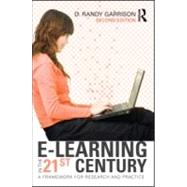
Note: Supplemental materials are not guaranteed with Rental or Used book purchases.
Purchase Benefits
What is included with this book?
| List of Illustrations | p. ix |
| Preface to the Second Edition | p. xi |
| Preface to the First Edition | p. xiii |
| Acknowledgments | p. xvii |
| Introduction | p. 1 |
| E-Learning Described | p. 2 |
| A New Reality | p. 3 |
| Conclusion | p. 5 |
| The Conceptual Framework | p. 7 |
| Theoretical Foundations | p. 9 |
| Philosophical Perspective | p. 9 |
| A Transactional View | p. 10 |
| Responsibility and Control | p. 11 |
| Theoretical Concepts | p. 12 |
| Approaches | p. 13 |
| Principles | p. 15 |
| Text-Based Communication | p. 16 |
| Conclusion | p. 17 |
| Community of Inquiry | p. 19 |
| The Learning Community | p. 20 |
| A Theoretical Framework | p. 21 |
| Social Presence | p. 23 |
| Cognitive Presence | p. 24 |
| Teaching Presence | p. 24 |
| Indicators | p. 25 |
| Theoretical Development | p. 26 |
| A Theory? | p. 27 |
| Conclusion | p. 29 |
| Social Presence | p. 30 |
| A Non-Verbal Community | p. 30 |
| Developments | p. 33 |
| Categories of Social Presence | p. 37 |
| Interpersonal Communication | p. 37 |
| Open Communication | p. 39 |
| Cohesive Responses | p. 39 |
| Practical Implications | p. 40 |
| Conclusion | p. 41 |
| Cognitive Presence | p. 42 |
| Conceptual Background | p. 42 |
| Critical Thinking | p. 43 |
| Practical Inquiry | p. 45 |
| Developments | p. 47 |
| Cognitive Presence Descriptors | p. 51 |
| Conclusion | p. 53 |
| Teaching Presence | p. 54 |
| Roles and Functions | p. 55 |
| Design and Organization | p. 56 |
| Facilitating Discourse | p. 58 |
| Direct Instruction | p. 59 |
| Developments | p. 60 |
| Conclusion | p. 62 |
| Applying the Col Theoretical Framework | p. 63 |
| Instructional Technologies | p. 65 |
| Historical Perspective | p. 65 |
| E-Learning Technologies | p. 67 |
| Web 2.0 | p. 68 |
| Social Media | p. 68 |
| Mobile Learning | p. 70 |
| Teaching and Technology | p. 72 |
| Conclusion | p. 73 |
| Blended Learning | p. 75 |
| Blended Learning Described | p. 75 |
| Scenarios | p. 76 |
| Online Blended Learning | p. 77 |
| Why Blended Learning | p. 78 |
| Conclusion | p. 82 |
| Guidelines for Practice | p. 83 |
| Learning Activities | p. 84 |
| Teaching-Learning Guidelines | p. 85 |
| Design and Organization | p. 86 |
| Facilitating Discourse | p. 92 |
| Direct Instruction | p. 96 |
| Conclusion | p. 98 |
| Assessment and Evaluation | p. 100 |
| Assessing E-Learning | p. 100 |
| Functions of Assessment | p. 101 |
| Assessing Participation | p. 102 |
| Assessment Activities | p. 106 |
| Course Evaluation | p. 110 |
| Conclusion | p. 112 |
| Organizational Issues | p. 113 |
| Strategic Innovation | p. 113 |
| Policy Development | p. 115 |
| Infrastructure | p. 117 |
| Leadership | p. 117 |
| Collaborative Leadership | p. 119 |
| Conclusion | p. 122 |
| Future Directions | p. 123 |
| The First Decade | p. 124 |
| The Second Decade | p. 125 |
| Future Research | p. 127 |
| Social Presence | p. 127 |
| Cognitive Presence | p. 128 |
| Teaching Presence | p. 128 |
| CoI Survey | p. 129 |
| Methodology | p. 131 |
| Conclusion | p. 131 |
| Appendix: Community of Inquiry Survey Article | p. 133 |
| References | p. 144 |
| Index | p. 155 |
| Table of Contents provided by Ingram. All Rights Reserved. |
The New copy of this book will include any supplemental materials advertised. Please check the title of the book to determine if it should include any access cards, study guides, lab manuals, CDs, etc.
The Used, Rental and eBook copies of this book are not guaranteed to include any supplemental materials. Typically, only the book itself is included. This is true even if the title states it includes any access cards, study guides, lab manuals, CDs, etc.